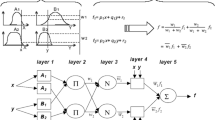Abstract
In the developing of an optimal operation schedule for dams and reservoirs, reservoir simulation is one of the critical steps that must be taken into consideration. For reservoirs to have more reliable and flexible optimization models, their simulations must be very accurate. However, a major problem with this simulation is the phenomenon of nonlinearity relationships that exist between some parameters of the reservoir. Some of the conventional methods use a linear approach in solving such problems thereby obtaining not very accurate simulation most especially at extreme values, and this greatly influences the efficiency of the model. One method that has been identified as a possible replacement for ANN and other common regression models currently in use for most analysis involving nonlinear cases in hydrology and water resources–related problems is the adaptive neuro-fuzzy inference system (ANFIS). The use of this method and two other different approaches of the ANN method, namely feedforward back-propagation neural network and radial basis function neural network, were adopted in the current study for the simulation of the relationships that exist between elevation, surface area and storage capacity at Langat reservoir system, Malaysia. Also, another model, auto regression (AR), was developed to compare the analysis of the proposed ANFIS and ANN models. The major revelation from this study is that the use of the proposed ANFIS model would ensure a more accurate simulation than the ANN and the classical AR models. The results obtained showed that the simulations obtained through ANFIS were actually more accurate than those of ANN and AR; it is thus concluded that the use of ANFIS method for simulation of reservoir behavior will give better predictions than the use of any new or existing regression models.













Similar content being viewed by others
References
EL-Shafie AH, El-Manadely MS (2011) An integrated neural network stochastic dynamic programming model for optimizing the operation policy of Aswan High Dam. Hydrol Res 42:50–67. doi:10.2166/nh.2010.043
Jothiprakash V, Shanthi G (2006) Single reservoir operating policies using geneticalgorithm. Water Resour Manag 20:917–929
Tu M, Hsu N, Yeh WW (2003) Optimization of reservoir management and operation with hedging rules. J Water Res Plan Manag 129:86–97
Faber BA, Stedinger JR (2001) Reservoir optimization using sampling SDP with ensemble stream flow prediction (ESP) forecast. J Hydrol 249:113–133
Lettenmaier DP, Wood EF (1993) Handbook of hydrology. McGraw-Hill, New York
Ngo LL, Madsen H, Rosbjerg D (2007) Simulation and optimization modeling approach for operation of the HoaBinh reservoir, Vietnam. J Hydrol 336:269–281
Kindler J (1992) Rationalizing water requirements with aid of fuzzy allocation model. J Water Resour Plan Manag 118:308–323
Keskin ME et al (2006) Adaptive neural-based fuzzy inference system (ANFIS) approach for modeling hydrological time series. J Hydrol Sci 5:588–598
El-Shafie A, Taha MR, Noureldin A (2007) A neuro-fuzzy model for inflow forecasting of the Nile River at Aswan high dam. Water Resour Manage 21:533–556. doi:10.1007/s11269-006-9027-1
Liong SY et al (2000) River stage forecasting in Bangladesh: neural network approach’. J Comput Civil Eng 14:1–8
Lekkas DF et al (2000) Application of artificial neural networks for flood forecasting. Glob Nest Int J 6:205–211
Hsu KL, Gupta HV, Sorooshian S (1995) Artificial neural network modeling of the rainfall Runoff process. Water Resour Res 31:2517–2530
Harboe R, Gautam TR, Onta PR (1994) Conjunctive operation of hydroelectric and thermal power plants. J Water Resour Plan Manage 120:778–793. doi:10.1061/(ASCE)0733-9496(1994)120:6(778)
Shahin M, VanOorschot HJL, De Lange SJ (1993) Statistical analysis in water resources engineering. A.AaBalkema, Rotterdam
Wurbs R (1996) Modeling and analysis of reservoir system operations. Prentice-Hall, Upper Saddle River
McCulloch WS, Pitts W (1943) A logic calculus of the ideas immanent in nervous activity. Bull Math Biophys 5:115–133
Rumelhart DE, Hinton GE, Williams RJ (1986) Learning internal representations by error propagation. In: Rumelhart DE, McClelland JL (eds) Parallel distributed processing. MIT Press, Cambridge
Flood I, Kartam N (1994) Neural networks in civil engineering. I: principles and understanding. J Comput Civil Eng 8:131–148
Ripley BD (1994) Neural networks and related methods of classification. J Roy Stat Soc 56:409–456
Sarle WS (1994) Neural networks and statistical models. In: Proceedings of the nineteenth annual SAS users group International conference pp 1538–1550. SAS Institute
Maier HR, Dandy GC (2001) Neural network based modeling of environmental variables: a systematic approach. Math Comput Model 33:669–682
Kothari R, Agyepong K (1996) On lateral connections in feedforward neural networks. In: Proceedings of IEEE International conference on neural networks, Institute of Electrical and Electronics Engineers, New York, pp 13–18
Barron AR (1993) Universal approximation bounds for superposition of a sigmoid al function. IEEE Trans Inf Theory 39:930–945
Agyepong K, Kothari R (1997) Controlling hidden layer capacity through lateral connections. Neural Comput 9:1381–1402
Baum E, Haussler D (1989) What sized net gives valid generalization? Neural Inf Process Syst 1:81–90
Bishop CM (1995) Neural networks for pattern recognition. Oxford University Press, New York
El-Shafie A, Abdin AE, Noureldin A, Taha MR (2009) Enhancing inflow forecasting model at Aswan high dam utilizing radial basis neural network and upstream monitoring stations measurements. Water Resour Manage 23:2289–2315. doi:10.1007/s11269-008-9382-1
Chen SC, Cowan FN, Grant PM (1991) Orthogonal least squares learning algorithm for radial basis function networks. IEEE Trans Neural Netw 2:302–309
Chen SS, Billings A, Grant PM (1990) Recursive hybrid algorithm for non-linear system identification using radial basis function networks. Int J Control 55:1051–1070
Fausett L (1994) Fundamentals of neural networks. Prentice Hall, Englewood Cliffs
Bishop CM (1996) Neural networks for pattern recognition, 1st edn. Oxford University Press, UK
Johnson D, King M (1988) Basic forecasting techniques. Butterworth, London
Acknowledgments
This research is supported by a research grant to the second author by smart Engineering System, University Kebangsaan Malaysia; and Science Fund project 01-01-02-SF0581, ministry of science, Technology and Innovation (MOSTI). The author thanks Puncak Niaga for providing the data for Sg. Langat dam.
Author information
Authors and Affiliations
Corresponding author
Rights and permissions
About this article
Cite this article
Fayaed, S.S., El-Shafie, A. & Jaafar, O. Adaptive neuro-fuzzy inference system–based model for elevation–surface area–storage interrelationships. Neural Comput & Applic 22, 987–998 (2013). https://doi.org/10.1007/s00521-011-0790-4
Received:
Accepted:
Published:
Issue Date:
DOI: https://doi.org/10.1007/s00521-011-0790-4




